
Collinsia heterophylla, known as purple Chinese houses or innocence, is a flowering plant native to California and the Peninsular Ranges in northern Baja California.
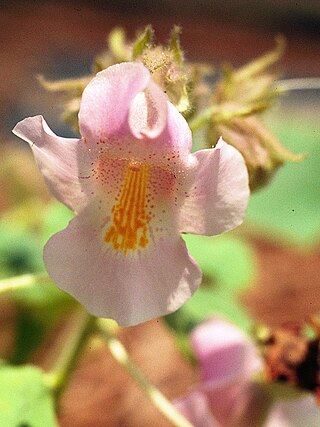
Proboscidea is a genus of flowering plant in the family Martyniaceae, some of whose species are known as devil's claw, devil's horn, ram's horn, or unicorn plant. The plants produce long, hooked seed pods. The hooks catch on the feet of animals, and as the animals walk, the pods are ground or crushed open, dispersing the seeds. The name devil's claw is shared with the South African plant Harpagophytum procumbens.

Halesia, also known as silverbell or snowdrop tree, is a small genus of four or five species of deciduous large shrubs or small trees in the family Styracaceae.

Vitex parviflora is a species of plant in the family Verbenaceae, also known as smallflower chastetree or the molave tree. The name "molave" is from Spanish, derived from mulawin, the Tagalog word for the tree. It is also known as tugas in Visayan languages. It yields one of two woods from the same genus called molave wood, the other being Vitex cofassus.

Sisyrinchium montanum, the blue-eyed-grass, American blue-eyed-grass, or strict blue-eyed grass, is a grass-like species of plant from the genus Sisyrinchium, native to northern North America from Newfoundland west to easternmost Alaska, and south to Pennsylvania in the east, and to New Mexico in the Rocky Mountains. It has also been introduced to parts of France, likely during the First World War.
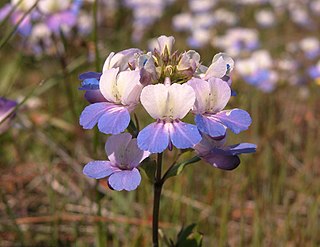
Collinsia grandiflora is a species of flowering plant in the plantain family known by the common names giant blue eyed Mary and large-flowered collinsia. This wildflower is native to western North America from British Columbia to northern California where it grows in coniferous understory and woodland.
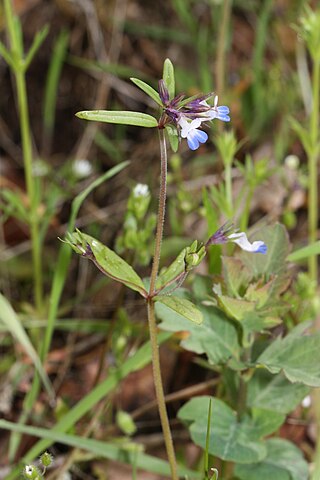
Collinsia parviflora is a species of flowering plant in the family Plantaginaceae known by the common names maiden blue eyed Mary and small-flowered collinsia.

Rostraria is a genus of plants in the grass family, native primarily to Eurasia and North Africa with one species native to South America. Hairgrass is a common name.

Collinsia parryi is a species of flowering plant in the plantain family known by the common name Parry's blue eyed Mary. It is endemic to central and southern California, where it is found in the southern Coast Ranges and in the Transverse Ranges north and east of Los Angeles.
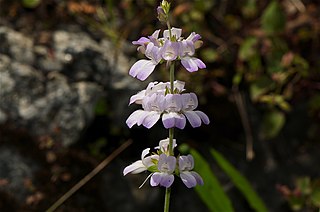
Collinsia bartsiifolia is a species of flowering plant in the plantain family known by the common name white blue-eyed Mary.

Collinsia callosa is a species of flowering plant in the plantain family known by the common name desert mountain blue-eyed Mary. It is endemic to California, where it grows in the mountains of the southernmost Sierra Nevada, the Transverse Ranges, and the mountains of the Mojave Desert region. It grows in desert scrub, chaparral, and woodland habitat on the mountain slopes.

Collinsia childii is a species of flowering plant in the plantain family known by the common name Child's blue-eyed Mary.
Collinsia greenei is a species of flowering plant in the plantain family known by the common name Greene's blue-eyed Mary.
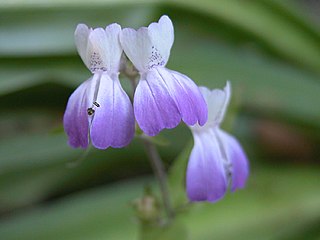
Collinsia multicolor is a species of flowering plant in the plantain family, known by the common names San Francisco blue eyed Mary and San Francisco collinsia. It is endemic to the San Francisco Bay Area, where it is known from San Francisco to Santa Cruz. As of 2008 there are 22 known occurrences. Populations south of Santa Cruz have been extirpated.

Collinsia sparsiflora is a flowering plant in the family Plantaginaceae known by the common names spinster's blue-eyed Mary and few-flowered collinsia. One variety of the species is native to the West Coast of the United States as far north as Washington, while the other three varieties are limited to California alone.

Collinsia torreyi is a species of flowering plant in the plantain family known by the common name Torrey's blue-eyed Mary. It is native to California and adjacent sections of Oregon and Nevada, where it grows in the coniferous forests of several mountain ranges, including the Sierra Nevada.

Collinsia verna, or blue-eyed Mary, is a winter annual that is native to the eastern and central parts of North America but has become endangered in the states of New York and Tennessee. The flowers are bicolored white and blue. It is a plant of valley bottoms and moist bottom slopes, in areas with moderate lighting and requires some shade.

Tetragonotheca is a genus of North American plants in the family Asteraceae. Nerveray is a common name for plants in this genus.

Lespedeza violacea, commonly known as wand lespedeza or violet lespedeza, is a species of herbaceous plant in the legume family.
Blue-Eyed Mary may refer to:


















